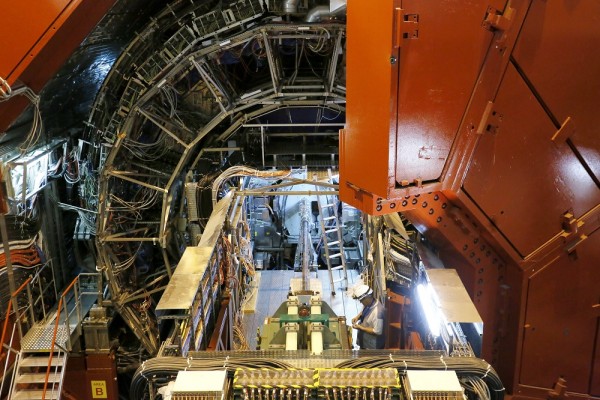The Large Hadron Collider Detects Extremely Rare Particle Decays; B Meson Detected
| Aishwarya Bhatt | | May 14, 2015 12:52 PM EDT |
(Photo : Reuters) Scientists working on the Large Hadron Collider recently announced that the LHC detected a rare particle decay which is pretty impossible to detect otherwise.
Scientists working on the Large Hadron Collider recently announced that the LHC detected a rare particle decay which is pretty impossible to detect otherwise. Called the B meson, it is pretty less famous than Higgs Boson particle, but since it was detected with the help of none other than the LHC, it could play a very important role in the Standard Model of particle physics, said reports.
Like Us on Facebook
The Standard Model governs the particle physics as it allows scientists to classify the sub atomic particles and also make predictions about the processes and particles which are yet to be discovered, states Gizmodo. The discovery and existence of the Higgs boson is the biggest living example of the success rate of the Standard Model and its predictions.
The category of the current particle falls into the sub atomic particle Mesons, and according to the Standard model, these strange mesons should be decaying at a rate of four times the rate of decay of the non-strange mesons. This rate is equivalent to one in 10 billion.
The CMS and LHCB teams also detected the decaying of these strange B mesons particles for the first time; it was never seen before in any other particle accelerator, states The Science Reporter. The rate of their decay was as per the predications of the Standard Model. But since only few particles were detected, nothing more can be said about the nature of these rare particles.
Scientists know it since a long time that the Standard Model is not entirely a fool proof model; it is known for its shortcomings and lack of explaining things about the anti matter, dark energy and the dark matter. But it is still evaluated to be one of the most precise models.
TagsLarge Hadron Collider, Large Hadron Collider Set to Discover New Particles from Higgs Boson and Dark Matter, LHC large hadron collider dark matter god particle higgs boson new theory, Large Hadron Collider is Back : Dark Matter Could Originate from 'God Particle', Large Hadron Collider news, Large Hadron Collider detects new rare particle decay, Large Hadron Collider B meson, Large Hadron Collider updates, Large Hadron Collider science, b meson, b meson news, b meson updates, b meson nasa, b meson LHC, b meson detected, b meson particle decay, higgs boson particle, Higgs Boson particle news
©2015 Chinatopix All rights reserved. Do not reproduce without permission
EDITOR'S PICKS
-

Did the Trump administration just announce plans for a trade war with ‘hostile’ China and Russia?
-

US Senate passes Taiwan travel bill slammed by China
-

As Yan Sihong’s family grieves, here are other Chinese students who went missing abroad. Some have never been found
-

Beijing blasts Western critics who ‘smear China’ with the term sharp power
-

China Envoy Seeks to Defuse Tensions With U.S. as a Trade War Brews
-

Singapore's Deputy PM Provides Bitcoin Vote of Confidence Amid China's Blanket Bans
-

China warns investors over risks in overseas virtual currency trading
-

Chinese government most trustworthy: survey
-

Kashima Antlers On Course For Back-To-Back Titles
MOST POPULAR
LATEST NEWS
Zhou Yongkang: China's Former Security Chief Sentenced to Life in Prison

China's former Chief of the Ministry of Public Security, Zhou Yongkang, has been given a life sentence after he was found guilty of abusing his office, bribery and deliberately ... Full Article
TRENDING STORY

China Pork Prices Expected to Stabilize As The Supplies Recover

Elephone P9000 Smartphone is now on Sale on Amazon India

There's a Big Chance Cliffhangers Won't Still Be Resolved When Grey's Anatomy Season 13 Returns

Supreme Court Ruled on Samsung vs Apple Dispute for Patent Infringement

Microsoft Surface Pro 5 Rumors and Release Date: What is the Latest?












